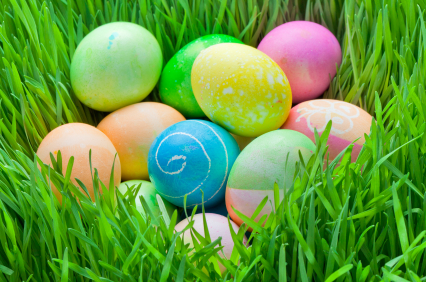If you have read my newsletters before, you will remember from Halloween that while I believe in celebrating and enjoying holidays I do not support the use of food dyes. It is one thing if your child is having one treat with a dye…but Easter, like all of the other holidays is full of much more than that.
Jelly Beans, Cadbury Easter Eggs, Easter Candy, and Coloured Easter Eggs are just a few things that mark the traditions of this Holiday.
And really, can we blame the kids?
Who wouldn’t to eat blue, pink, and yellow sugar bombs that taste delicious!! After all, we are programmed to desire and be drawn to the taste of sugar, fat and salt.
It is only when that frontal lobe matures that we realize maybe it isn’t great to be eating dye that has been linked to cancer, birth defects and conditions such as hyperactivity and ADHD.
So what to do?
Have a Dye Free (or at least reduced dye) Easter Holiday
1) Naturally Dye your Easter Eggs
Many people don’t worry about the food dye in Easter eggs, as the shell isnt ingested. Health professionals tell us that food dye is safe in small quantities, so that slightly bluish tinged egg that you are eating is not a problem once a year. What about those little hands that get covered with the dye during the colouring process. Again everything in moderation…but when there are so many natural options, why take the risk.
It is true that once a year a small ingestion of food dye will not do any harm, but given all of the foods like cheese and cereal on the market these days with food dyes added, it is best to avoid everything whenever possible. While I couldnt find any studies to link Easter Egg Dye on the hands to anything conclusive, common sense would say that since the skin is your largest detox organ, and toxins in sunscreen and lotions are absorbed through the skin into the bloodstream that food dye would be no different. I dont know about your kids, but mine are covered by the time the process if over.
My motto is make the changes when they are easy, and let go of the occasional times when things are not so easy. The truth is, your kitchen is full of natural dyes. Common food items such as red cabbage, onion skins, and coffee can be used to transform plain white eggs into colorful Easter gems. Kids will especially love discovering all the different colors they can create — let them experiment using hard-boiled eggs and bowls of cold dyes.
Dye Recipes
INSTRUCTIONS:
- Select a dyeing agent, and place it in the pot using the amount listed below.
- Add 1 quart water and 2 tablespoons white vinegar to pot; if more water is necessary to cover ingredients, proportionally increase the amount of vinegar.
- Bring to a boil, then lower heat.
- Allow the ingredients to simmer for 30 minutes.
- Strain dye into a bowl.
DYEING AGENTS:
- Red-cabbage dye: 4 cups chopped cabbage
- Turmeric dye: 3 tablespoons turmeric
- Onion-skin dye: 4 cups onion skins (skins of about 12 onions)
- Beet dye: 4 cups chopped beets
- Coffee dye: 1 quart strong black coffee (instead of water) Cold-Dipping Method
Color Glossary
Natural dyes can sometimes produce unexpected results, so don’t be surprised if, for example, your red-cabbage dye yields blue eggs. Use the following guide to help you achieve the colors you desire.
- Deep Gold: Boil eggs in turmeric solution, 30 minutes.
- Sienna: Boil eggs in onion-skin solution, 30 minutes.
- Dark, Rich Brown: Boil eggs in black coffee, 30 minutes.
- Pale Yellow: Soak eggs in room-temperature turmeric solution, 30 minutes.
- Orange: Soak eggs in room-temperature onion-skin solution, 30 minutes.
- Light Brown: Soak eggs in room-temperature black coffee, 30 minutes.
- Light Pink: Soak eggs in room-temperature beet solution, 30 minutes.
- Light Blue: Soak eggs in room-temperature cabbage solution, 30 minutes.
- Royal Blue: Soak eggs in room-temperature cabbage solution overnight.
- Lavender: Soak eggs in room-temperature beet solution, 30 minutes. Follow with room-temperature cabbage solution, 30 seconds.
- Chartreuse: Soak eggs in room-temperature turmeric solution, 30 minutes. Follow with room-temperature cabbage solution, 5 seconds.
- Salmon: Soak eggs in room-temperature turmeric solution, 30 minutes. Follow with room-temperature onion-skin solution, 30 minutes.
from MarthaStewart.com
2) Go for Natural Candy/Chocolate
While the natural candy still has as much sugar as any other candy, they usually are free of artificial dyes and additives.
You can find these at the health food store, or even the health food section of your grocery store. I saw camino chocolate bunnies at Zehrs on the weekend!
I bought mine through well.ca as I find it challenging to get out of the house these days. They had some natural fuzzy peaches, which if I ever eat candy…this is the one I would pick!
3) Give a Prize Instead
My mother started this with me when I was little, and I looked so forward to it every year. She would make a treasure hunt and stuff clues in the Easter eggs instead of candy. I would open the egg and it would take me all over the house and outside searching for the next clue. At some of the stops I would get a prize…and some I would get chocolate. It sure made my Easter experience a great one…and gave me a ton of exercise in the process!
